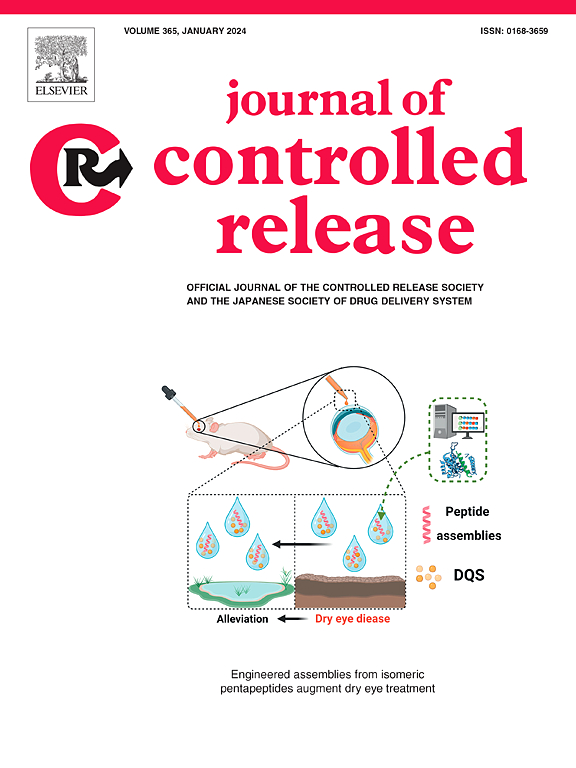利用基于肽的细胞穿透纳米颗粒增强 CRISPR-Cas9 RNA 系统的递送,实现高效的体外和体内应用
IF 10.5
1区 医学
Q1 CHEMISTRY, MULTIDISCIPLINARY
引用次数: 0
摘要
CRISPR-Cas9 系统已成为一种革命性的基因编辑工具,在解决包括癌症在内的各种疾病的潜在基因病因方面具有巨大的治疗潜力。然而,要将其应用于临床,还必须克服传递方法等挑战。除了核酸酶降解的风险和CRISPR-Cas9系统被巨噬细胞快速清除之外,Cas9的大尺寸、高阴离子电荷密度和RNA的亲水性也阻碍了其在细胞内的递送和整体基因转染效率。ADGN 肽能与 CRISPR-Cas9 RNA 形成稳定的自组装纳米颗粒。它们能够穿过各种类型细胞的细胞膜,对过度表达层粘连蛋白受体的癌细胞表现出偏好,并在将 RNA 运送到细胞质之前对其进行保护。我们证明,ADGN肽能显著促进体外CRISPR-Cas9介导的荧光素酶基因敲除,效率高达60%,且偏好G插入荧光素酶基因的靶位点。此外,我们还提供了证据,证明这些纳米颗粒也可以在小鼠体内进行系统性静脉注射,将功能性 CRISPR-Cas9 系统输送到小鼠体内正位植入的肿瘤肺细胞中,从而在小鼠体内实现有效的基因敲除。我们还证明,ADGN-RNA 的体内分布受其多肽与 RNA 摩尔比的影响。本研究介绍了一种新型肽基纳米颗粒,它能以 RNA 形式递送 CRISPR-Cas9 系统,适用于体外和体内模型,前景广阔。本文章由计算机程序翻译,如有差异,请以英文原文为准。


Enhanced CRISPR-Cas9 RNA system delivery using cell penetrating peptides-based nanoparticles for efficient in vitro and in vivo applications
CRISPR-Cas9 system has emerged as a revolutionary gene-editing tool with huge therapeutic potential for addressing the underlying genetic causes of various diseases, including cancer. However, there are challenges such as the delivery method that must be overcome for its clinical application. In addition to the risk of nuclease degradation and rapid clearance of the CRISPR-Cas9 system by macrophages, the large size of Cas9, the high anionic charge density and hydrophilic nature of the RNA hinder their intracellular delivery and overall gene transfection efficiency.
In this study, we engineered a novel Peptide-Based Nanoparticles ADGN for the delivery of long RNA. ADGN peptides can form stable self-assembled nanoparticles with CRISPR-Cas9 RNA. They have the ability to cross the cell membrane of various cell types, exhibiting a preference for cancer cells that overexpress laminin receptor and safeguard RNA prior their delivery into the cytoplasm. We demonstrate that ADGN peptides significantly promote CRISPR-Cas9 mediated knockout of the luciferase gene in vitro achieving 60 % efficiency with a preference for G insertion at the targeted site of luciferase gene. Moreover, we have provided evidence that these nanoparticles can also be systemically intravenously administrated in vivo in mice to deliver a functional CRISPR-Cas9 system to tumoral lung cells orthotopically implanted in the mouse, resulting in an effective gene knockout in mice. We also demonstrated that the in vivo distribution of ADGN-RNA is influenced by its peptides to RNA molar ratio. This study introduces a promising new Peptide-Based Nanoparticles for delivering CRISPR-Cas9 system in its RNA form applicable in both in vitro and in vivo models.
求助全文
通过发布文献求助,成功后即可免费获取论文全文。
去求助
来源期刊

Journal of Controlled Release
医学-化学综合
CiteScore
18.50
自引率
5.60%
发文量
700
审稿时长
39 days
期刊介绍:
The Journal of Controlled Release (JCR) proudly serves as the Official Journal of the Controlled Release Society and the Japan Society of Drug Delivery System.
Dedicated to the broad field of delivery science and technology, JCR publishes high-quality research articles covering drug delivery systems and all facets of formulations. This includes the physicochemical and biological properties of drugs, design and characterization of dosage forms, release mechanisms, in vivo testing, and formulation research and development across pharmaceutical, diagnostic, agricultural, environmental, cosmetic, and food industries.
Priority is given to manuscripts that contribute to the fundamental understanding of principles or demonstrate the advantages of novel technologies in terms of safety and efficacy over current clinical standards. JCR strives to be a leading platform for advancements in delivery science and technology.
 求助内容:
求助内容: 应助结果提醒方式:
应助结果提醒方式:


